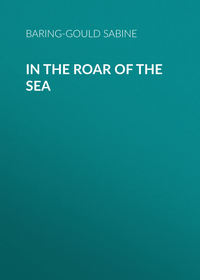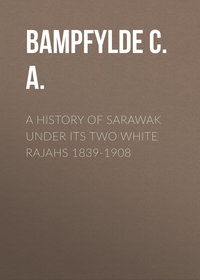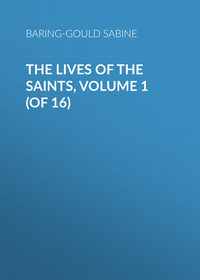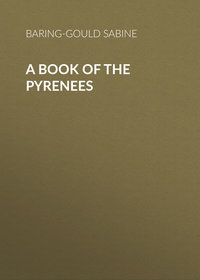 полная версия
полная версияBrittany
Plounevez-Moedec on very high ground, traversed by the main road from Paris to Brest, straight as a bowstring. The church has a 2nd pointed arcade and E. windows and N. aisle. The rest flamboyant. The gallery at the W. end is one removed from the chapel of Keramanach, with the vaulting wantonly taken away. The tower, renaissance, has been restored recently. The chapel of Keramanach (S. Fiacre) may be visited equally well from Belle Ile or from Plouaret. It is late 2nd pointed with square end, E. window and S.E. window of same period, as also N. aisle. There are remains of good stained glass in the windows. The porch has rich 16th cent. groining. The W. bell turret has a gallery. The chapel contains a fine alabaster reredos of the 15th cent., each panel has been let into a wooden frame. On the road from Plounevez to Trégrom is a menhir 30 ft. high.
Locquenvel. Church of 15th and 16th cents. with stained glass representing the legend of S. Envel.
Belz (M.) chl. arr. Lorient. In very desolate country. The road from Auray runs through plantations of Austrian pine grown for the Welsh collieries, or over furzy moors. Belz itself is an utterly uninteresting place, with an ugly church, and a ruinous but large chapel near it. Belz lies, however, near the curious inland sea of Etel, and was formerly head of a pou or pagus. A mile and a half beyond Belz is the hamlet of S. Cadou, occupied entirely by fishermen and their families. The women wear scarlet petticoats which they take care to display. A stone causeway 140 ft. leads to the Isle of S. Cadou and his chapel. S. Cadoc, son of Gwynllyw, King of Gwent or Monmouthshire, arrived here about 525 and founded a monastery and school on the island. To facilitate the passage and repassage of his pupils he constructed the causeway, having learned the art of dyking at Llancarvan. It was here, pacing it with Gildas, that they discussed the salvability of Virgil. Cadoc, who loved that author, could not believe that he was lost, but Gildas held the harsher view. As they talked, Cadoc turned over his Virgil to point out some remarkable passages, probably the prophecy of the Incarnation, to his friend, when the wind swept the volume out of his hand into the sea. He slipped in rushing to recover it, and some pieces of iron in the causeway are supposed to indicate where his foot slid. Only with difficulty did Cadoc recover the precious book. The chapel has an early Romanesque apse, with rudely carved capitals to the pillars supporting the chancel arch. The chapel was much spoiled at its alteration in 1842. In the S. transept is the stone bed of S. Cadoc with a receptacle under it, in which strange sounds are thought to be heard. These are due to the echo of the waves and winds. The gallery of the flamboyant screen has been removed to the W. end. In the nave are four paintings. (1) S. Cadoc arriving at the isle; (2) S. Cadoc settling on it; (3) Pirates land and he protests that he has nothing; (4) Cadoc departing, with the inscription: —
Oratoire mon œuvre adieu, dit-il pleurant,
Belz t'oublierai je? Non. Il cingla de céans.
P. S. after 21st Sept. Numerous megalithic remains are to be found about Belz. A menhir at Kervoen, another at Mélionec; remains of an allée couverte 30 ft. long at Kernours; a dolmen in good condition at Kerlutu; others at Kerhuen, Kervoen and Kerlourd. At Crubelz in a tumulus is a chamber of masonry nearly 11 ft. high. Roman bricks were found in it, and it would seem to have been constructed in Gallo-Roman times, but in accordance with earlier traditions and usages.
Locoal, on an arm of the sea of Etel, united to the mainland by a causeway like that at S. Cadou. Locoal was a locus penitentiæ of S. Gudeval or Gurval, Bishop of Aleth. He scooped out a cave and dwelt therein. Disciples came to him to the number of 188. To protect themselves against the high tides they erected the dykes that still remain. At length, desiring greater retirement in his extreme old age, Gudeval retired with seven disciples into the forest of Camors, where he died in 640. Some lechs remain; one near the cemetery is 4 ft. high, with a cross cut on it in relief, surmounted by a circle and cross. Another on the way from Locoal to Mendon, 7 ft. 6 in. high, with two crosses cut on it, bears on it the words CRUX PROSTLON; it is the tombstone of the wife of Count Pasquitien, the murderer of King Solomon. She died in 875. The parish church was burnt by the Spaniards in 1592, and again accidentally in 1765.
Etel, at the mouth of the channel that connects the inland sea with the ocean, is a small port partly closed by a rock and by moving sands. Near the village is a dolmen with seven supporters. A little further on is one with five.
Erdeven (Ar deven = on the sand-downs). All this district is covered with wind-blown sands. The most remarkable prehistoric monument is the alignment of Kerzerho, which extends over two miles and a quarter, and is composed of 1030 stones, with, however, gaps caused by pilferers. Unhappily the stones are still being broken up and carried away. The lines are on the S. and S.E. of the village. After passing an isolated menhir and a ruined cairn, the rows are reached running east. Then comes a gap where the stones have been carried off to build walls, but presently they reappear, the blocks smaller. Then ensues another hiatus, and then another succession of ranges of fine stones stretching to a tumulus. The northern line reaches to a tumulus, the Mané Bras. On the summit are the ruins of two dolmens, with traces of an enclosing circle of uprights. To the east of Kerangre is another group of monoliths. At Mané Groh are two dolmens. The dolmen of Corcomo is the finest in Morbihan.
Plouhinic. Near Kerfourchen two fallen dolmens and a menhir. From the windmill to the west alignments running S.E. Near the Mill of Gueldra the lines recommence in eight rows, and may be traced to Kervué and Kervelhué.
Bourbriac (C.N.) chl. arr. Guingamp. The church is in part Romanesque, and possesses a crypt. The windows are of 15th cent. The tower 1635. At Tanvedou is a tumulus enclosing a dolmen.
S. Adrien. Chapel of Avangour, 1576, with marble retable of same period.
Cadout (S. Illtyd). Church of 14th and 15th cents., with a sculptured retable. On high ground the manor house of Bois-de-la-Roche, 15th cent. restored.
Bréhat (Isle de) (C.N.). Opposite Roscoff lighthouses. On the Isle of Lavré the remains of a Celtic monastery have been traced, consisting of a group of bee-hive huts and an oblong chapel. One hut is fairly perfect, and is kept in repair as a sea mark. In the church is preserved a piece of oriental silk called the stole of S. Pol de Léon.
* BREST (F.) chl. d'arrond. Was a fishing village about a mediæval castle on the site of a Roman camp, till Cardinal Richelieu resolved on giving to France the command of the seas, when he fixed on Brest for a great dockyard, 1631. His undertaking was not followed up by Mazarin, but Colbert pursued it with energy, and extensive works were executed. Thanks to this great minister and to Admiral Duquesne, Brest became a naval and military port of the first class. The Breton parliament had not relished the undertaking, and forbade the delivery of timber to the royal works, and ordered the cessation of the forging of cannon, but the royal will was supreme, and the opposition of the parliament disregarded. The port was extended, and the rocks blasted; barracks, storehouses, workshops, were created, and fine quays were constructed. Vauban fortified it, Recouvrance was united to Brest by a turning bridge. From Brest issued a fleet of 80 ships of the line under Tourville in the naval campaigns of 1690 and 1691. In 1694 an Anglo-Dutch fleet in vain attempted an attack on Brest. In the 18th cent. its quays and fortifications were extended. Granite basins were constructed capable of receiving vessels of 120 guns. Dajot, whilst engaged on the defences of the place, constructed the terrace planted with elms, that gives such a fine view of the harbour. Issuing from Brest, the fleet commanded by d'Orvilliers met, July 27, 1778 the English fleet off Ouessant. A French convoy was guarding a fleet of vessels laden with grain from America, when it was attacked by Admiral Howe. The French were under Admiral Villaret de Joyeuse. The English fleet, which had been in quest, had been for four days unable to find the French owing to fog. The engagement took place on the 27th July. There were 26 French men-of-war and 35 English.
After Trafalgar Napoleon abandoned the ambition of making France a great naval power, and it was not till under Napoleon III. that fresh activity was displayed at Brest.
The harbour is perhaps the finest in Europe. It is 36 kilometres in circumference, and is entered only through the channel of the Goullet, illumined by five lighthouses.
The castle of the 13th cent., on a precipitous rock, is flanked by seven towers; the two largest are on the N.E., and the entrance is between them. The tower of Azenore belongs to the end of the 12th cent., and takes its name from the mother of S. Budoc, who was daughter of the Count of Léon, and married to the Count of Goelo. The tower of Caesar of the 12th cent., that des Anglais is of 1374, that de la Madelaine is of the 15th cent., as is also the donjon.
Brest, apart from its dockyard, is a very uninteresting place. The Church of S. Louis (1692-1778) is ugly, with modern stained glass in the French style representing Breton saints. But Brest may be made a centre for some interesting excursions, as to Landevennec, which is more easily reached from Brest by steamer than by road.
Landevennec is where a very important abbey was founded by S. Winwaloe, in French Guenolé, at the beginning of the 6th century. The Saint had settled first in the islet of Tibidy, but finding the place too strait for him, came to Landevennec, where King Grallo granted him lands in a warm and sheltered situation, under a hill that cut off the blasts from the Atlantic. The ruins are in private grounds, but visitors are admitted. The abbey church is of the 11th cent., and is without transepts, but has a large chapel of a later date built on at one side. In a crypt is the reputed tomb of King Grallo. The monastic buildings were rebuilt in the 17th century. The Grève des Anglais is so called because it was here that landed an expedition against Brest which failed, because betrayed to the French Court by Marlborough and Godolphin. The consequence was that eight hundred British soldiers fell into a trap and were butchered to the last man.
Goueznou. Here is the sole church near Brest that possesses any archæological value. But it is a really remarkable edifice. It has the finest apse in the Department, next to Lampaul-Guimiliau, containing three great gabled late flamboyant windows. The church also possesses a tower with two galleries crowned by a spire. The porch was begun in 1643, and belongs to the same family as those of Landerneau and Trémaouézan. It was finished in 1644, so that there was no long delay in its completion. The main body of the church was constructed in 1607-15. About ten paces west of the church is the monumental fountain of the Saint. It consists of a tank in an enclosure surrounded by stone seats for the accommodation of bathers. On the south side is a small altar surmounted by a niche, that contains a statue of S. Gouezenou. P. Ascension Day. Lambezellec, with a modern church, has a much frequented Pardon on the 2nd S. in August. Plouzané. Lechs and menhirs. P. Sunday nearest 10th Aug.
Guipavas. The church possesses a porch enriched internally with statues, 1565.
Le Conquet. Modern church, but with glass of the 16th cent. preserved in it. In it is the tomb of Michel de Nobletz, a famous Jesuit, born 1577, died 1654, whose beatification is proposed. He laboured in Lower Brittany to turn the people from their pagan superstitions. On the promontory of Kermorvan two dolmens and a circle of upright stones.
Plougonvelen. Fine coast scenery. Here, in an imposing position above the sea, are the ruins of the Abbey of S. Mathieu. The monastery was destroyed at the Revolution. The church (1152-1208) was much altered in the 14th and 15th cents. The abbey was founded in the 6th cent. by S. Tanguy. Near it is now a lighthouse. Of the parish church the only portions that are ancient are the porch and the N. transept. P. Sunday nearest 21st Sept. Off the promontory can be seen the clusters of islands leading in a N.W. direction to Ouessant. Of these the Ile de Banque, le Guéménés, and the Ile Molène are the principal. Ouessant and these islands can be reached from Conquet, a steamer leaving there thrice a week. The Ile Molène is only three-quarters of a mile long and about half-a-mile wide, and contains 570 inhabitants. Property in it is minutely subdivided. It was here that the bodies were washed ashore after the wreck of the Drummond Castle on June 16, 1896. The Ile d'Ouessant is about seven miles long and three broad; plenty of fresh water is found on the island, that contains 2280 inhabitants. It was here that Paulus Aurelianus, a native of Glamorganshire, landed when migrating from Britain at the head of a considerable party. He, however, did not remain above two or three years in the island, and then crossed over to the mainland. The church Lampaul (Lann-Paul) on Ouessant was founded by him. The cliffs are abrupt, and the rocks pierced with caves and natural arches. The island produces potatoes, and gives good feed to sheep. It is in process of being extensively fortified for the protection of Brest.
Broons (C.N.) chl. arr. Dinan. Bertrand du Guesclin was born here in 1320. The castle has completely disappeared, but a column has been erected on the site in commemoration of the fact.
Sevignac. The Château of Brondineuf of the 12th cent. is well preserved.
Cancale (I. V.) chl. arr. S. Malo. A little port, and a favourite watering place. It is noted for its oysters. During one part of the year nearly all the male population is absent on the banks of Newfoundland engaged in the cod-fisheries. The rochers de Cancale are a mass of granite rising precipitously above the sea not far from the mainland. Much granite is quarried at Cancale. The church of S. Méen is modern.
* CARHAIX (F.) chl. arr. Châteaulin. An old Roman town, Vorganium, lies high and in dreary country. Scanty remains of a Roman aqueduct are pointed out. The church (S. Tremor) is modern and good, with a fine East window; the tower is of 1529-35, with a West doorway, the carving of foliage on which is deserving of notice. More interesting is the church of Plouguer, originally very early in the 11th cent., containing some arches and piers and clerestory windows. It was enlarged in the 16th cent. (1574), and was ruthlessly mutilated in the 18th when the flamboyant tracery was hacked out of the windows, and the screen was demolished. The tower is remarkably fine, with bold splayed belfry windows. It was intended to support a spire which was never added. There is a handsome old house in the town of carved stone and timber. P. at S. Roque last S. but one in August.
Carnoet on very high ground. Here is the peniti or place of retreat of Gildas with a chapel, by the river, and high up in a clump of trees under a camp that dates from the invasion of Brittany by the Northmen, is a curious chapel of S. Gildas of late flamboyant melting into renaissance. It has a W. spirelet, gallery and two bells, the spirelet sustained on an arch. Within, sunk in the pavement, is an 11th cent. sarcophagus, reputed to be the bed of S. Gildas, who died in 570. In the N. aisle is a range of six stages of fowl hutches. On the Pardon, 29th Jan., the peasants make offerings of fowls and horsehair; the former are put into these hutches where they cluck and cackle through mass, and then are sold by auction for the benefit of the chapel and its maintenance. The camp above is an admirable typical example of the Norseman fortress, consisting of a tump, hollowed out in the middle, that sustained a wooden superstructure; and a base-court.
Cleden-Poher has a large church of the middle of the 16th cent., but with alterations made in 1689, at which date the sacristy was built. It has a fine west porch, and in the apse a good flamboyant window in six bays with a column up the centre against which, within, stands a statue. In a Chapel of N.D. de Cleden the vault is covered with paintings of the 18th cent. The high altar has a retable into which are let sculptured panels of the 16th cent., and others, representing the seven sacraments, are about the apse. The venerated image of N.D. dates from the 14th cent. The Calvary in the graveyard is of 1575. At the N.E. corner of the churchyard is an ossuary, transition between flamboyant and renaissance. P. 15th Aug.
Treffrin (C.N.) possesses a fine Roman camp at Kermoisan, with remains of a tower in it. The Church of N.D. is of 1580, the porch of 1582, richly decorated, and contains niches within containing statues of the twelve apostles; the corbels supporting them are all different in design.
Locarn. The church is of the 12th cent. with additions and alterations of the 16th. It contains the tomb of the patron, S. Harn, in granite, 14th cent. The east window has stained glass of 1572 representing scenes of the Passion. The pulpit is renaissance, syrens occupy the angles. There is a Holy Well with an early statue of the Saint above it. A Calvary, the base ornamented with sculptured dolphins. In the presbytère is a magnificent silver-gilt processional cross of the 16th cent. In the parish are several menhirs, at Quellence Buis, Loquevel, Grand Follezon, etc., but of no great height.
Le Moustoir (C.N.). Church of 1507, in the shape of a T. The cornice, on which rests the vault, represents grotesque figures and groups. The E. window retains its old glass, representing the Life of the Virgin. In the tracery are the four great prophets. On the N. side a fireplace for heating the water for baptism.
Maël Carhaix (C.N.). On the Place is a Roman military milestone with inscription stating that it was erected in the reign of Septimius Severus. The Church of S. Pierre (1530) has old stained glass representing the Fathers of the Church and Bishops. The glass is of the same date as the church. At Maël Carhaix is the cave whence issues the spring that supplied Vorganium with water by an aqueduct.
* CARNAC, com. of Quiberon. Noted for the vast numbers of its prehistoric monuments. It lies on the low flat shores of the Baie de Quiberon, and is a great place for the cultivation of oysters. To obtain a good general view of the place it is well to ascend first of all the Mont S. Michel, a huge cairn piled up over a natural elevation of granite. It is oblong in shape and rises to about 60 feet. On the summit is a chapel of the Archangel, with an old granite cross. The mound was dug into in 1863 when a dolmen was discovered that contained over a hundred polished stone axes, a necklace, and other objects of the early bronze age. Further excavation in 1890 has disclosed another dolmen, in which, along with some stone implements, were two bronze buttons. The cairn is built up carefully of stones laid in order over a sheet of pebbles, and above them more of the same and of seaweed had been spread, and then above this fresh stones have been piled. From the summit the alignments of Carnac can be seen on the north. To visit these latter the following course should be pursued. Take the road to Ker Malvezin, and in a few minutes, on a bit of rising ground on the left is seen a dolmen on which a cross has been erected. Very soon after the road traverses the lines of Le Menec. There are still standing eleven of these rows and they run from E.N.E. to W.S.W. The total length is 3510 feet, and there are 1169 stones in them. The tallest of them is 13 feet high, but the majority from 3 to 4 feet. It is well to turn to the left and pursue the rows to the western extremity where is a semi-circular enclosure, evidently not in its original condition, and it is doubtful whether it be not a modern erection made out of stones pilfered from the rows to form a farm enclosure attached to the farm of Le Menec.
Having retraced our steps to the road, we cross it and follow the avenues of upright stones till we reach and cross another road, that to Ploemel. The road has broken through the lines, which continue only a few yards to the east, and then are brought to a conclusion by blocking stones, that is to say, slabs set at right angles to the lines. From this point ensues a gap for about 345 yards where is a little plantation of Austrian pines, a stone quarry, and some furzy enclosures. The lines are not, however, wholly interrupted; a few upright stones and several that are prostrate testify that there was some continuation. We follow a new road through the plantation and between walls till we come abruptly on a fresh cluster of stones, and these the largest we have yet seen. This is the commencement of the Kermario group. These started from several tumuli enclosing dolmens, but of such only one, an allée couverte pertaining to the southernmost line, remains. The lines though mutilated are instructive. They start from this allée couverte and run about 250 yards to a pair of blocking stones, planted at right angles to the rows. The Kermario alignments run N.E. up a hill crowned by a disused windmill that has been constructed out of the blocks, then they continue some way till walls and a wood interrupt their course. Ten rows remain, and the number of the standing stones is 982. The largest of the menhirs is prostrate; apparently it had been purposely thrown down to form a coverer to a Gallo-Roman grave that has been discovered beneath it. What is of special interest is the fact that a Roman camp was formed in these lines, and that those who constructed the camp made use of the stones for their wall of enclosure, breaking up some, and employing others in their original position where it served their purpose. From the easternmost end of the Kermario group occurs an interruption of about 398 yards, and then we come upon a third set of stone rows, that of Kerlescant, which stretches 885 yards, but is much mutilated about the village. Thirteen lines can be traced containing 540 stones, but there were others, some 40, that lie to the north, and are the poor remains of another series of stone rows. On the east again the alignment is supposed to describe a curve towards the north, and then recommence and run east again to the Crach estuary. Near the rows is also a ruined allée couverte. The whole extent of rows cannot be estimated as short of 4½ miles.
Poor fragments of other alignments remain at Ste. Barbe, near a couple of windmills by the station of Plouharnel, and again, and remains of a stone circle by the dolmen of Keriaval. The dolmens are very numerous, but not in the commune of Carnac to the extent that they are in the adjoining parishes. An enumeration of them may be omitted here, as at Carnac for a franc at the Musée Milne may be had a serviceable little book, "Carnac et ses Monuments," by M. Le Rouzic, with a map. One word of caution must however be given – not to accept the wild theories promulgated relative to dolmens and alignments. A close and scientific comparative study of these monuments has led to a pretty certain determination as to their purposes. The dolmens and allées couvertes were sepulchres, family or tribal; and the alignments consist of stones erected by members of the tribe or families belonging to the tribe in honour of the several dead who were laid in the dolmens. The stone circles were either places where the dead were burned and funeral feasts were held, or were places of tribal gatherings for palavers; generally they served both purposes. Isolated menhirs were either memorials to the dead, or boundary marks between tribal lands. All dolmens were originally buried under cairns or tumuli.
The parish church at Carnac was rebuilt in 1639 and has a well proportioned tower and spire, with spirelets at the angles. Above the west door is a statue of S. Cornelius, who throughout Lower Brittany is the patron of horned beasts, as S. Eloi (Eligius, B. of Noyon) is of horses. On the north side is an extravagant baroque porch, with a stone crown or baldachin above it. The fountain of S. Cornély is west of the church. A tramway now connects Carnac with Belz and Erdeven.









